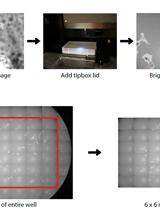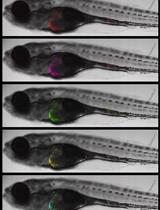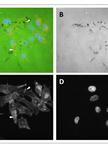- Submit a Protocol
- Receive Our Alerts
- Log in
- /
- Sign up
- My Bio Page
- Edit My Profile
- Change Password
- Log Out
- EN
- EN - English
- CN - 中文
- Protocols
- Articles and Issues
- For Authors
- About
- Become a Reviewer
- EN - English
- CN - 中文
- Home
- Protocols
- Articles and Issues
- For Authors
- About
- Become a Reviewer
Transwell Cell Migration Assay Using Human Breast Epithelial Cancer Cell
Published: Vol 2, Iss 4, Feb 20, 2012 DOI: 10.21769/BioProtoc.99 Views: 73411

Protocol Collections
Comprehensive collections of detailed, peer-reviewed protocols focusing on specific topics
Related protocols

PhagoKinetic Track Assay: Imaging and Analysis of Single Cell Migration
Michiel Fokkelman [...] Bob van de Water
Jan 5, 2016 10740 Views

In vivo Drug Screening to Identify Anti-metastatic Drugs in Twist1a-ERT2 Transgenic Zebrafish
Joji Nakayama [...] Zhiyuan Gong
May 20, 2023 1986 Views
Abstract
Transwell migration assays have been widely used for studying the motility of different types of cells including metastatic cancer cells. The assay is also useful in screens for compounds that act as chemoattractants or inhibitors of chemotaxis for cells. The assay employs a permeable layer of support, usually a tissue-culture-treated microporous membrane, which is positioned between two compartments that mimic two different sets of microenvironments for cell survival/growth. Cells on one side of the membrane, when sensing chemoattractants placed on the other side of the compartment that diffuses through the membrane, can migrate through the pores in the membrane towards the source of the chemoattractants. Cells that migrate across the membrane can be quantified by fixing and counting. Human breast epithelial adenocarcinoma MD-231 cells grow relatively fast and are metastatic. The MB-231 cell line is used here to describe the procedures of an in vitro cell migration assay using the transwell apparatus.
Materials and Reagents
- Human MDA-MB-231 cell (ATCC, catalog number: HTB-26 ™)
- Dulbecco's modified eagle medium (DMEM) (Life Technologies, Invitrogen™, catalog number: 10313-021 )
- Fetal bovine serum (FBS) (ATCC, catalog number: 30-2020 ™)
- Trypsin-EDTA (Life Technologies, Invitrogen™, catalog number: 25200-056 )
- Trypsin inhibitor (soybean) (Life Technologies, Invitrogen™, catalog number: 17075-029 )
- Phosphate buffered saline (PBS) (Life Technologies, Invitrogen™, catalog number: 14190-144 )
- Collagen I (Sigma-Aldrich, catalog number: C7661 ) or Fibronectin (BD Biosciences, catalog number: 354008 )
- Glutaraldehyde (Sigma-Aldrich, catalog number: G6257 )
- Ethanol (Sigma-Aldrich, catalog number: 459836 )
- Crystal violet (Sigma-Aldrich, catalog number: C3886 )
- TCC-formulated Leibovitz's L-15 Medium (ATCC, catalog number: 30-2008 ™)
Equipment
- Corning® Transwell® polycarbonate membrane inserts (Sigma-Aldrich, catalog number: CLS3421 ) or Millicell Cell Culture Inserts (EMD Millipore, catalog number: PI8P01250 )
- Cotton swabs
- Cell culture incubator: 37 °C and 5% CO2
Procedure
- Carry MB-231 cells in DMEM with 10% FBS (use L-15 medium if needed).
- Wash cells twice with 1x PBS and trypsinize.
- Add 0.5 mg/ml Trypsin inhibitor in PBS to inactivate an equal volume of Trypsin. Aspirate cells by pipetting up and down gently (Note: It is important to break down into individual cells as much as possible).
- Gently spin down the cells. Wash cells two times with DMEM containing 0.5% FBS to remove trace amounts of trypsin and inhitibor. Resuspend the cells in DMEM with 0.5% FBS and count.
- Prepare the transwell compartments, 24-well format, with 8 μm pore size insert:
- To the lower compartment, add 2.6 ml of DMEM with 0.5% FBS containing 40 μg ml-1 Collagen I.
- Add the transwell insert to the well by merging the bottom of the insert into the medium in the lower compartment.
- To the lower compartment, add 2.6 ml of DMEM with 0.5% FBS containing 40 μg ml-1 Collagen I.
- To the upper compartment, gently add 1 x 105 cells from step 4.
- Incubate the cells in the transwell plate at 37 °C and 5% CO2 for 2.5 h. This allows cells to migrate toward the underside of the insert filter.
- After 2.5 h, carefully take the insert out. Cells that do not migrate through the pores and therefore remain on the upper side of the filter membrane need to be gently removed with a cotton swab. Gently wipe the upper side of the filter membrane with a cotton swab to remove the cell debris. We recommend that use each clean cotton swab for one wipe only, in one direction and do not swipe in back-and-forth movement. The cotton swab can be slightly moisturized with ddH2O as needed but be sure to remove any excess water. Several wipes may be needed to completely remove any cell debris on the membrane.
- Fix the cells on the lower side of the insert filter quickly with 5% glutaraldehyde for 10 min.
- Next, stain cells on the lower side of the insert filter with 1% crystal violet in 2% ethanol for 20 min.
- Remove excess crystal violet by quickly merging the insert in ddH2O for 3 to 4 sec. Drain excess water from the side of the insert using a cotton swab. Dry the insert membrane.
- Count the number of cells on the lower side of the filter under a microscope. Randomly choose different views and take average counting.
- The same experimental procedure should be performed for control groups without chemoattractants. Each migration condition should be tested with replicates.
Acknowledgments
This protocol was developed in the Department of Immunology, Scripps Research Institute, La Jolla, CA, USA and adapted from Katoh et al. (2006) and Nakamizo et al. (2005). The work was funded by NIH grants CA079871 and CA114059, and Tobacco-Related Disease, Research Program of the University of California, 15RT-0104 to Dr. Jiing-Dwan Lee [see Chen et al. (2009)].
References
- Chen, Y., Lu, B., Yang, Q., Fearns, C., Yates, J. R., 3rd and Lee, J. D. (2009). Combined integrin phosphoproteomic analyses and small interfering RNA--based functional screening identify key regulators for cancer cell adhesion and migration. Cancer Res 69(8): 3713-3720.
- Katoh, H., Hiramoto, K. and Negishi, M. (2006). Activation of Rac1 by RhoG regulates cell migration. J Cell Sci 119(Pt 1): 56-65.
- Nakamizo, A., Marini, F., Amano, T., Khan, A., Studeny, M., Gumin, J., Chen, J., Hentschel, S., Vecil, G., Dembinski, J., Andreeff, M. and Lang, F. F. (2005). Human bone marrow-derived mesenchymal stem cells in the treatment of gliomas. Cancer Res 65(8): 3307-3318.
Article Information
Copyright
© 2012 The Authors; exclusive licensee Bio-protocol LLC.
How to cite
Chen, Y. (2012). Transwell Cell Migration Assay Using Human Breast Epithelial Cancer Cell. Bio-protocol 2(4): e99. DOI: 10.21769/BioProtoc.99.
Category
Cancer Biology > General technique > Cell biology assays > Cell migration
Cancer Biology > Invasion & metastasis > Drug discovery and analysis > Cell migration
Cell Biology > Cell movement > Cell migration
Do you have any questions about this protocol?
Post your question to gather feedback from the community. We will also invite the authors of this article to respond.
Share
Bluesky
X
Copy link









